
Hakea nodosa, commonly known as yellow hakea, is a shrub that is endemic to Australia. It usually has golden yellow flowers in profusion and needle-shaped leaves.
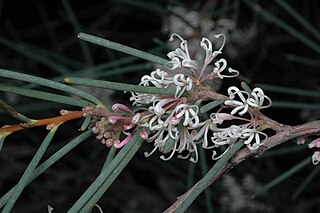
Hakea cycloptera, commonly known as elm-seed hakea, is a shrub in the family Proteaceae endemic to South Australia. It is a small spreading shrub with an abundance of pale pink or white flowers from December to August.

Hakea lorea, commonly known as bootlace oak or cork tree, is a species of shrub or small tree in the family Proteaceae found in central and northern Australia. It has needle-shape leaves, yellow, white or green flowers and hard corky bark.

Hakea tephrosperma commonly known as hooked needlewood, is a shrub or small tree species in the family Proteaceae. It has cream flowers, needle-shaped leaves and is one of the taller species adaptable for dry to temperate locations.
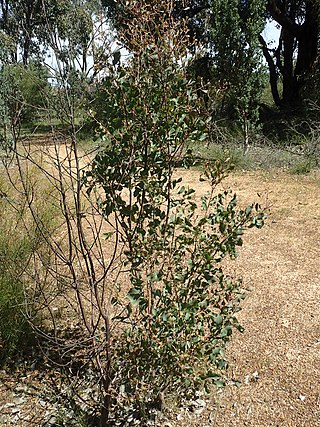
Hakea auriculata is a species of flowering plant in the family Proteaceae endemic to Western Australia. A very showy species in full bloom with creamy white, yellow, dark red or reddish purple fragrant flowers.

Hakea bicornata is a shrub in the family Proteaceae native to Western Australia, with attractive creamy-white flowers and fruit with two distinctive horns.
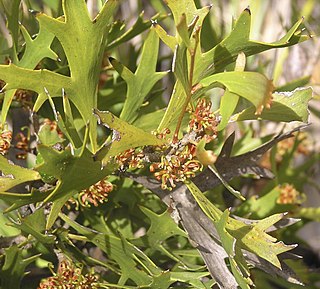
Hakea ceratophylla, commonly known as the horned leaf hakea, is a shrub in the family Proteaceae. It is endemic to the southwest of Western Australia. It is a stiff shrub with variably-shaped leaves that are sometimes lobed and flowers with white or rusty-coloured hairs.

Hakea carinata is a species in the family Proteaceae native to an area in South Australia. It is a frost hardy small to medium shrub adaptable to a range of free draining situations. Its prickly habit creates a good wildlife habitat.

Hakea collina is a shrub in the Proteaceae native to eastern Australia. A small many branched shrub with gnarled branches with attractive cream-yellowish flowers.
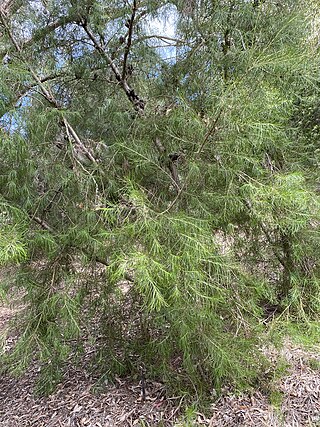
Hakea constablei is a shrub in the Proteaceae family native to eastern Australia. A bushy shrub or small tree with a profusion of white or cream flowers in spring.

Hakea divaricata, commonly known as needlewood, corkbark tree or fork-leaved corkwood, is a tree or shrub in the family Proteaceae native to an area in central Australia. A slow growing species with up to 120 showy cream to greenish-yellow flowers in long racemes from June to November.

Hakea cyclocarpa, commonly known as the ram's horn, wild bean or curved-fruit hakea is a shrub in the family Proteaceae. A strongly scented species with large creamy-white flowers with a red style and interesting fruit. Native to an area along the west coast and south west regions of Western Australia.

Hakea incrassata, commonly known as marble hakea, is a shrub in the family Proteaceae and is endemic to Western Australia.

Hakea kippistiana is a shrub in the family Proteaceae and endemic to Western Australia. It is a dense prickly shrub with sharp needle-shaped leaves with fragrant white, cream or pink flowers from November to February.
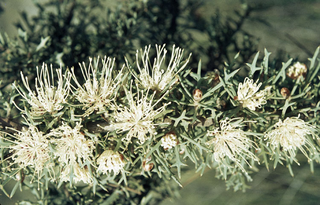
Hakea lasiocarpha, commonly known as long styled hakea, is a shrub in the family Proteaceae and is endemic to Western Australia. It has about 30 whitish flowers in clusters in the upper leaf axils, rigid prickly leaves and a limited distribution.

Hakea linearis is a shrub or tree in the family Proteaceae and is endemic to Western Australia. It has smooth branches, mostly linear leaves and white flowers.

Hakea stenophylla is a shrub or tree in the family Proteaceae, with sweetly scented creamy-white flowers. It is endemic to Western Australia.

Hakea strumosa is a shrub in the family Proteaceae endemic to an area in the Wheatbelt, Great Southern and the Goldfields-Esperance regions of Western Australia. A dense, very prickly shrub with a profusion of small, deep pink or red flowers in spring.

Hakea vittata, commonly known as the striped hakea, hooked needlewood, is a shrub of the family Proteaceae. Restricted to an area on the Eyre Peninsula and the Gawler Range in South Australia and small areas in eastern Victoria.

Hakea pedunculata is a shrub or small tree in the family Proteaceae comprising approximately 150 species restricted to Australia. This species is found in the Far North region of Queensland and adjacent islands. It has flat, broadly egg-shaped leaves and white, cream or greenish flowers.





















